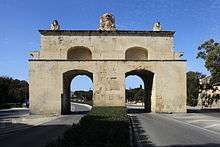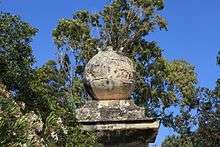Porte des Bombes
| Porte des Bombes | |
|---|---|
| Bieb il-Bombi | |
_02_ies.jpg) | |
| Former names | Porta dei Cannoni |
| General information | |
| Status | Intact |
| Type | Gate |
| Architectural style | Baroque |
| Location | Floriana, Malta |
| Coordinates | 35°53′25.6″N 14°30′7.5″E / 35.890444°N 14.502083°ECoordinates: 35°53′25.6″N 14°30′7.5″E / 35.890444°N 14.502083°E |
| Completed | 1721 |
| Renovated | 1868 |
| Cost | 6000 scudi |
| Renovation cost | £900 |
| Owner | Government of Malta |
| Technical details | |
| Material | Limestone |
| Design and construction | |
| Architect | Charles François de Mondion |
| Renovating team | |
| Architect | Col. E. W. Dunford |
Porte des Bombes (Maltese: Bieb il-Bombi, Italian: Porta delle Bombe, meaning "Bombs' Gate"), originally called Porta dei Cannoni (meaning "Cannons Gate"), is an ornamental arched gate in Floriana, Malta. It was originally built in 1721 as an advanced gate within the faussebraye of the Floriana Lines, and it was enlarged with the construction of a second archway in 1868. The ramparts on either side of the gate have since been demolished, leaving the gate looking like a triumphal arch.
History
_(14741077326).jpg)
Construction of the Floriana Lines began in 1636, but works proceeded slowly and the lines were only completed in the early 18th century. The lines had a large bastioned land front with outworks and a faussebraye. Porte des Bombes was built in 1720–21 within the faussebraye, being constructed to designs of the French architect Charles François de Mondion[1] at a cost of 6000 scudi.[2] The gate originally had a single arch, and it served as Floriana's outer entrance, leading to the town's main gate Porta Sant'Anna.[3] It was originally protected by a lunette.[4]
Porte des Bombes was captured by French soldiers during the French invasion of Malta in June 1798.[5]
In the mid-19th century the British government enlarged the gate by adding a second archway to accommodate the increasingly heavy traffic in the Grand Harbour area.[6] This enlargement was designed by the architect Col. E. W. Dunford of the Royal Engineers,[2] and it cost a total of £900. The second gate was inaugurated on 17 August 1868, during the governorship of Sir Patrick Grant.[5]
In the early 20th century, some of the ornamentation in the archways was removed so as to enable trams to pass through the gate. The lunette outside the gate was subsequently demolished to make way for a new road,[4] while the ramparts on either side of the gate were demolished in the 1930s to cope with the increasing volume of traffic.[2] These alterations resulted in the gate losing its legibility as part of the Floriana Lines, making it look like a triumphal arch.[7]

The gate was restored between September 2002 and March 2003, at a cost of Lm55,000. The restoration works also included the installation of a lighting system. The gate was vandalized in May 2005 when burnt oil was daubed on it, but the damage was cleaned within a couple of days.[6] On 24 October 2012, there was some damage when an Arriva bus skidded into it and two other buses later crashed into the first bus and 22 passengers were injured. However the damaged part of the gate was repaired a few days later.[8]
The gate and the rest of the Floriana Lines were included on the Antiquities List of 1925.[9] It is now scheduled as a Grade 1 national monument, and it is also listed on the National Inventory of the Cultural Property of the Maltese Islands.[7]
Architecture

Porte des Bombes was built in the Baroque style. The gate originally had a single arch, but the second arch on the left is a 19th-century addition. Each arched entrance is flanked by carved cannons, which gave the gate its original name Porta dei Cannoni, and each cannon has a relief of a coat of arms. The four cannons which formed part of the original gate bear the arms of Grand Master Ramon Perellos y Roccaful, while the two cannons on the second arch bear the royal coat of arms of the United Kingdom. The gate has a cornice above a row of carved Maltese crosses. Above the cornice are escutcheons bearing the coats of arms of the Order of St. John, Grand Master Perellos, and the United Kingdom, as well as two marble plaques with Latin inscriptions. The plaque on the right side of the gate reads:[5][10]

DVM THRACES VBIQUE PVGNO
(meaning While I fight the Turks everywhere, I am secure in my seat – 1721)
IN SEDE SIC TVTA CONSTO
MDCCXXI
The plaque on the left side reads:[5]
AD MAJOREM POPVLI
(meaning For the greater convenience of the public – 1868)
COMMODITATEM
MDCCCLXVIII

Three trophies, the central one bearing Perellos' arms, are found at the top of the gate. These all formed part of the original gate, but they were relocated when it was enlarged.[7]
Just outside the gate there are two pillars bearing stone balls which represent bomb shells. These gave the gate its present name Porte des Bombes.[11]
Porte des Bombes is one of only two gates in Malta which bear representations of life-sized artillery pieces, the other one being St. Helen's Gate which was built in 1736.[12]
In popular culture
- The gate is visible in the 2016 film 13 Hours: The Secret Soldiers of Benghazi.
References
- ↑ De Lucca, Denis (1981). "The contribution of Francois de Mondion in the architectural development of 18th century Malta" (PDF). Proceedings of History Week: 78. Archived from the original (PDF) on 17 April 2016.
- 1 2 3 Rizzo, Victor J. (2010). Discover Floriana – Historic Walks in a Green City (PDF). Floriana: Din l-Art Ħelwa & Floriana Local Council. pp. 40–41. ISBN 9789990998092. Archived from the original (PDF) on 29 May 2016.
- ↑ "Gateways that have vanished: Porta Sant'Anna, Floriana & Porta Haynduieli, Cottonera". The Malta Independent. 29 April 2014. Archived from the original on 21 September 2016.
- 1 2 "Floriana Lines – Floriana Lines" (PDF). National Inventory of the Cultural Property of the Maltese Islands. 28 June 2013. Archived from the original (PDF) on 19 August 2016.
- 1 2 3 4 "Porte des Bombes". Floriana Local Council. Archived from the original on 26 March 2016.
- 1 2 Testa, Michael (4 May 2005). "Vandals deface Portes des Bombes". Times of Malta. Archived from the original on 3 March 2016.
- 1 2 3 "Porte des Bombes – Floriana Lines" (PDF). National Inventory of the Cultural Property of the Maltese Islands. 28 June 2013. Archived from the original (PDF) on 19 August 2016.
- ↑ "Bus crash: Police list the injured – Arriva says diesel may have mixed with rainwater on the road". Times of Malta. 24 October 2012. Archived from the original on 3 March 2016.
- ↑ "Protection of Antiquities Regulations 21st November, 1932 Government Notice 402 of 1932, as Amended by Government Notices 127 of 1935 and 338 of 1939.". Malta Environment and Planning Authority. Archived from the original on 20 April 2016.
- ↑ Espinosa-Rodriguez, Antonio (1989). "Some reflections on the three views of Valletta and its environs at the Malta Chamber of Commerce" (PDF). Melita Historica. Malta Historical Society. 10 (2): 201–202. Archived from the original (PDF) on 16 April 2016.
- ↑ Pericciuoli Borzesi, Giuseppe (1830). The historical guide to the island of Malta and its dependencies. Malta: Government Press. p. 59.
- ↑ Spiteri, Stephen C. (6 September 2010). "Porta dei Mortari". MilitaryArchitecture.com. Archived from the original on 20 September 2016.
External links
| Wikimedia Commons has media related to Porte des Bombes. |